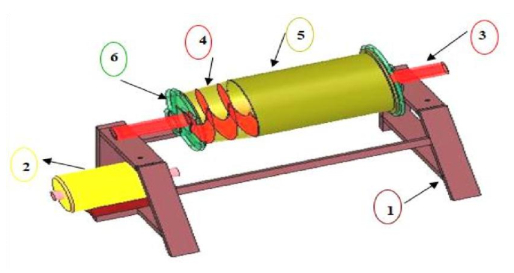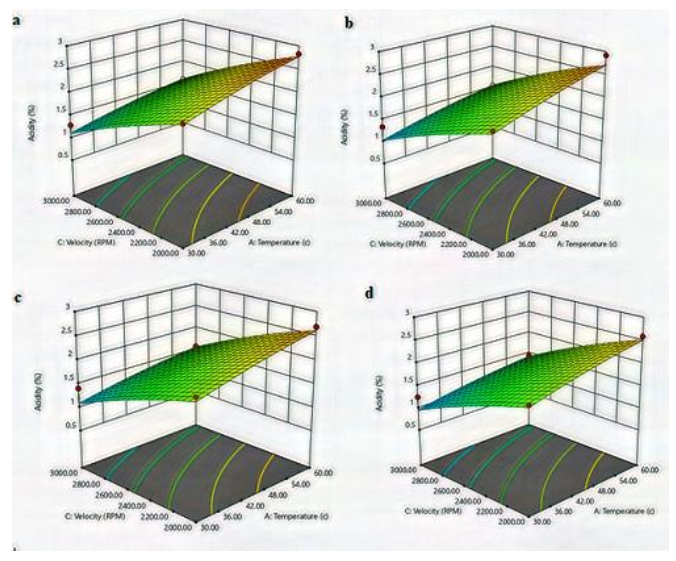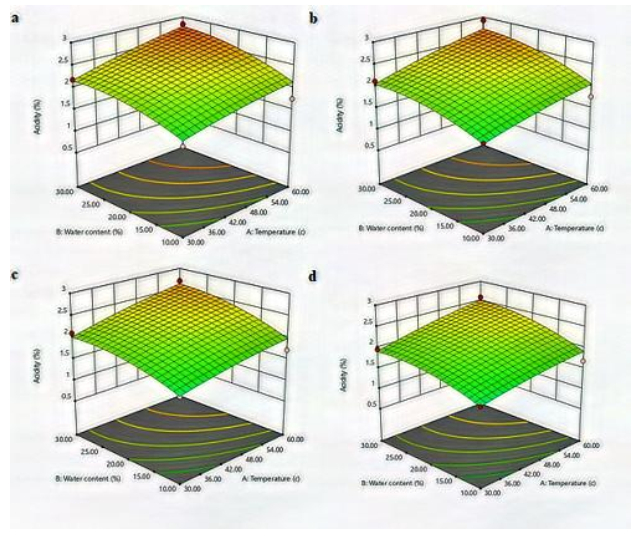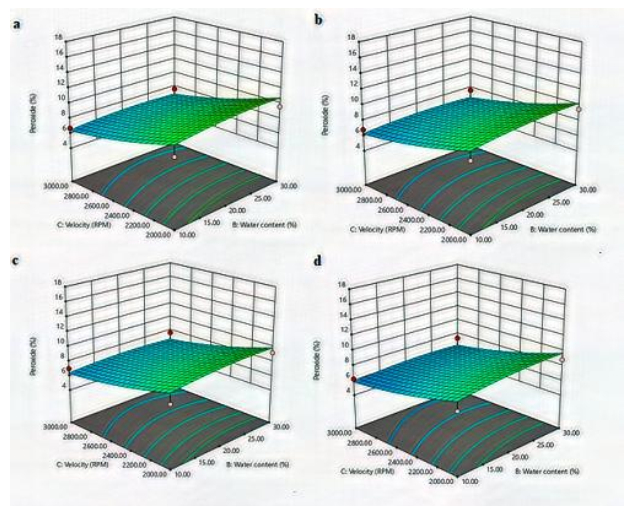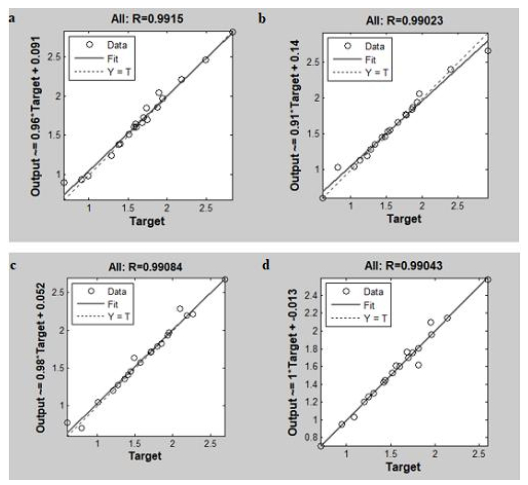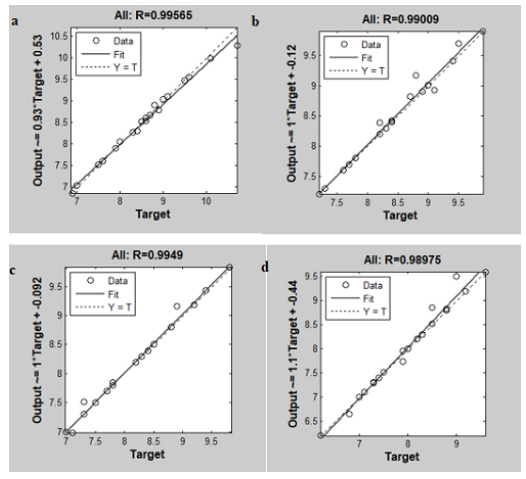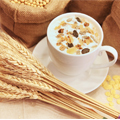Olive is a fruit rich in oils with beneficial properties. Two important factors for assessing olive oil are free fatty acids and peroxide quality. Nowadays, due to the progress in the food industry, machinery equipment has grown. The most important part of the processing line is the decanter. In order to reach a quality oil, it is necessary to pay attention to some indicators related to the machine operations. In this research, the effect of temperature of malaxer (three levels of 30, 45 and 60 °C), the amount of water injected into olive pomace (that water content reach to 10, 20 and 30%) and velocity of the rotary cylinder (three levels of 2000, 2500 and 3000 rpm) on the amount of free fatty acid and peroxide value of olive oil that extracted from the 3-phase decanter was evaluated. According to the obtained results, the amount of acidity and peroxide of olive oil is inversely proportional to the velocity of the decanter and is directly related to the temperature of the mixer encasement and content of water.
1.
Introduction
Olive crops are cultivated in countries with favorable weather conditions as a strategic product. Olive is one of the important plants on earth, and about 1200 varieties have been identified [1]. Olive fruit is considered to be a significant source of human nutrition in terms of its significant oil content. Also, about 1 liter of oil can be extracted from five kg of olive fruit [2]. As regard to chemical properties of olive, it is not possible to store olive fruit for a long time, hence it should be transported as soon as possible to factory for oil extraction [3].
Over the past few decades, the pharmaceutical properties of olive have been identified more than ever [4]. Olive oil is rich in vitamins and antioxidants and helps prevent heart attacks [5]. Olive oil with two types of oleic and linoleic unsaturated fatty acids that has a special advantage over other edible oils [6]. The nutritional benefits of olive oil depend on the composition of their fatty acids. Olive oil contains high levels of natural antioxidants that is effective in preventing many diseases [7]. Antioxidants, like phenolic compounds, prevent the oil from evaporating during cooking and, at the same time, create a good taste. The peroxide and free fatty acid index of olive oil is one of the most important indicators in determining the quality of olive oil [8].
Duo to the free fatty acid and peroxide value of olive oil that are very important factors for quality, the kind of olive and olive extraction oil equipment play significant role. In recent years, numerous studies have been done on the factors affecting the quality of oil factors during the process of producing olive oil.
Kubasek et al. (2005) carried out research about how heat dissipated in pressurized oil was affected and claimed that heat release necessarily depends not only on direct contact but also on the free conductivity of heat energy, and the viscosity of foods affected by these factors [9]. Torres and Maestri (2006) investigated the effects of extraction methods on chemical composition of virgin olive oils from Traslasierra Valley. Analysis of the effect of the extraction system, the values of analytical determinations, revealed statistically significant differences in some parameters, mainly in free fatty acid and phenol contents. Oxidative stability showed a significant correlation with phenol content. Most of the quality factors and fatty acid compositions showed significant variations among olive varieties. Nevadillo variety had the most values of oleic acid, whereas Manzanilla was considerable for its higher content of phenolic compounds. Hence, pressure-extracted oil from the Manzanilla variety presented better oxidative stability [10].
Inarejos-García et al (2009) performed a research about the Influence of malaxation conditions on virgin olive oil product. A continuous device of virgin olive oil extraction (Pieralisi, Fattoria) was used, which working at 200 kg/h olive pomace, and the pomace was mixed at different temperatures (20–40 ℃) and times (30–90 min). The quantity of extracted oil was improved when either the mixer temperature or the mixing time was increased, but the temperature more effective than the time (performance increased about 28%, from 20 to 40 ℃). The total phenol and o-diphenol contents in virgin olive oils, which both the sensory bitterness and the oxidative stability of the oils, greatly improved with the increasing temperature. On the contrary, a longer mix time only led to decrease in the total phenols. [11].
Klen and Vodopivec (2012) had an investigation over Traditional press compare to continuous two- and three-phase centrifuge (Figure 1). No qualitative differences in phenol profiles were observed between the systems, whereas significant ones at the quantitative level. Highest Crushing caused the phenols lost, since only 50–60% of total phenols were transferred from fruits to pomace, while their further partition depended on the solubility nature of phenols between phases produced. Only 0.5% of available phenols were found in olive oil, while the remains ended up in wastes (>40%) depending on the system used. A two-phase centrifuge provided the highest transfer rate of phenols to oil (1.5%) with the highest antioxidant potential (AOP), followed by a traditional press (1.2%) and a three-phase centrifuge (0.5%) where, most of the phenols were flushed away with the wastewater produced (>30%) [12].
As regard to mentioned points, it can be conclude that lot of factors play an important role in the quality of olive oil. In particular, the oiling system equipment used in the factories as well as the related parameters play a significant role in determining the quality of the oil. The purpose of this study was to investigate the effects of heat of encasement, speed of cylinders, and the amount of water added to the material compartment on Peroxidation and oxidation.
2.
Materials and methods
2.1. Preparation of olive samples
Considering the capacity of the processing line (about 350 kg/h), four olive cultivars named Manzanilla, Fishami, Kalamatata and Oily from the research station of Rudbar Ministry of Agriculture, Guilan province were prepared for oil extraction. Then, the olives were transferred to a mechanical laboratory of the Faculty of Agricultural Machinery for the uniformity of moisture. Then, for measuring, evaluating and determining the dynamic behavior of olive samples, the Santam SMT-20 test material and the Load cell 500 N were used for single axial compressive stress test at a speed of 8 mm/min. performing the test with 20 samples, which were randomly selected. In each test, according to the force-deformation diagram, the fracture point, the specification and the sample fracture force are read. Also, the energy for fracture the olive sample is obtained by calculating the surface under the force-deformation curve, and by dividing the amount of fracture energy into the sample volume, the amount of gravity was calculated.
2.2. Extraction system
According to Figure 2, the decanter used in this study includes the chassis, the electric motor, axis of the machine, the spiral conveyor, the encasement and the flange of the holder on the axle. According to the standards of the food industry, the crust was made of stainless steel. The main shaft is not only the machine support, but also the inlet (inject) of the olive pulp into the encasement and the drainage outlet from the chamber to the outside of the device. Table 1 also refers to the dimensions and characteristics of the spiral conveyor. All kinds of Olive were harvested from the research garden in the middle of October, with a mean index of 4.5 maturity, and was immediately transferred to the laboratory for oil extraction. Due to Evaluation of Data by RSM method, 20 olive oils for each cultivar were prepared.
2.3. Variable parameters
The material that enters the decanter is the pulp from crushing the olive fruit with some water (usually warm water). In the present study, three levels of 10, 20 and 30% of water were mixed with olives cake. The material (pomace) injected into the rotary pump is affected by the centrifugal force generated by the device and the cone shape of the device is divided into three phases, solid, liquid (intermixture water, pigments, etc.) and oil. In this research, the machine tool consists of a heat regulator under the olive mixing chamber. Heat has an important impact on the quality of olive. Therefore, the effect of three levels of temperature of 30, 45. 60 ℃ were evaluated. Furthermore, the velocity of rotary cylinder (decanter) that controlled by the inverter tested at three speeds of 2000, 2500 and 3000 rpm.
2.4. Quality parameters
The amount of free fatty acid and peroxide in the oil removed from the centrifuge machine can be considered as the basis for determining the quality and performance of the rotary pump. Therefore, the low value of the mentioned parameters of the olive oil indicates the good performance of the device in qualitative terms and vice versa. Finally, 5 grams of oil samples, 30 mg of acetic acid-chloroform solution were saturated with potassium iodide and sodium peroxide value was determined using sodium hyposulfite. Also, the acidity of olive oil was reported by the tantalization method (analytical methods of the Iranian Institute).
2.5. Evaluation of the effect of variable parameters on quality parameters
In this research, artificial neural network (ANN) was used in MATLAB software and response surface method in design expert software to analyze the obtained data. ANNs are one of the subcategories of artificial intelligence science that is widely used in data analysis and modeling. Various types of ANNs have been developed. Multilayer perceptron (MLP) is commonly used for classification and function approximation purposes.Input layer, hidden layer (s) and output layer constitute the MLP structure. MLP is a feed-forward neural network (FFNN), meaning that the data flows in one direction from input layer to output.
3.
Results and discussion
3.1. Mechanical properties
The physical and mechanical properties of olive have a profound effect on the oil extraction process in the decanter. The quantities of toughness, rapture energy and rapture force were obtained for four olive cultivars by the Santam SMT-20 test material. For this purpose, 20 samples of each variety were randomly selected and tested. According to the Table 2 the maximum mean fracture energy and fracture force of the Manzanilla variety were 0.280 and 141.315, respectively. Olive Manzanilla had more difficult physical characteristics than other varieties. In regard to oily variety, due to its high oil content, its oil content had the lowest fracture energy and fracture force. (0.221 and 92.264 respectively).
3.2. Effect of temperature and velocity on acidity of olive oil
Heat and velocity are among the most important factors in the efficiency of the decanter machine of olive oil. These two factors are very effective in both the quality and quantity of oil output from the decanter machine. The acidity of the oil was measured at three different temperatures and speeds. The Figure 3 which is related to the acidity of olive oil, showed that the acidity of olive oil is inversely proportional to the speed of rotating cylinders, and has a direct relation with the temperature of the mixer encasement. In general, the graphs for all samples showed the highest acidity (lowest quality) at 2000 rpm and the temperature of 60 ℃. The highest amount of acidity was related to the Kalamata variety (2.92%). Also, the lowest amount of acidity was for oily sample oil (0.53 %), when the velocity of the rotary cylinders was 3000 rpm and the temperature of the mixer encasement was 30 ℃.
3.3. Effect of temperature and water content on acidity of olive oil
The material that enters the olive oil decanter is a paste of olives. To achieve this goal, after crushing the olives, amount of water is added to the material. The amount of water injected into the material affects the function of the machine operator and, as a result, affects the quality of the output oil. In this research, three levels of 10, 20, and 30% water were injected in mixer encasement at different temperatures. According to Figure 4 it can be claimed that the quality of olive oil is inversely proportional to the amount of temperature and amount of added water. In all varieties, the most amount of acidity occurred when 30% of water was injected into the mixer encasement and the temperature reached the highest (60 ℃).Inversely, the best quality of the oil was obtained at 10% moisture content and 30 ℃.
3.4. Effect of velocity of rotary cylinder and water content on peroxide of olive oil
Peroxide and acidity are important factors in determining the quality of olive oil, and oil with lower acidity also has lower peroxide levels. According to Figure 5, it can be concluded that the amount of peroxide of olive oil from the decanter was inversely related to the velocity of the rotating cylinders and is directly related to the contents of the water injected into the olive dough. Among the samples, the highest peroxide value pertain to Manzanilla variety at the velocity of rotary cylinder of 2000 rpm and the content of water was 30 (10.7%) and the lowest amount of peroxide was 9.6%, which was related to the oily sample at velocity of 3000 rpm and content of water was 10%.
According to Table 3 and 4, the temperature of encasement, moisture content and rotary speed of decanter had an effect on the amount of acidity and peroxide, but the factors mentioned had no effect on each other. Also, the values of R, adjusted R2 and predicted R2 for the value of acidity were 0.92, 0.89 and 0.81 and also for the amount of peroxide were 0.73, 0.63 and 0.58, respectively.
3.5. Evaluation of ANN model
Structure of ANNs has an important role on output of developed models. The main parameters affecting the performance of ANNs are input variables, number of hidden layers and number of nodes in each hidden layer. So, in this research, MLP with one hidden layer was used in the structure of ANNs. To obtain the best model with the highest performance, ANNs with different number of neuron in the hidden layer was performed and evaluated. Figure 6 show the best R2 of ANNs that related to performance of temperature, velocity of rotary cylinder and water content on acidity. The best result among four varieties was related to Manzanilla with using topology of 3-8-1.
The performance of temperature of mixer encasement, the water content and the velocity of rotary cylinders of the decanter were modeled on the amount of peroxide of the olive oil that performed by the neural network. For this purpose, the neural network of one secret layer and 1-20 neurons were used and the best results for each variety were reported. Based on Figure 7, the best results for Manzanilla, Kalamata, Fishemi and oily were obtained with topology of 3-8-1, 3-14-1, 3-61 and 3-19-1 respectively, and the best result pertain to the Manzanilla (R2 = 0.995) and the weakest result related to the oily variety (R2 = 0.989).
In this regard, Jimxenez et al performed an ANN model for optimization of olive oil elaboration process. An artificial neural network was built for model of the moisture and fat content in olive pomace using two-phase olive oil processing. Technological variables were used as input, including olive paste flow, olive paste temperature and water dilution level. The results obtained indicate a very good predictive capacity of the three-layer ANN model with values of r = 0.961 and RMSEP = 0.32% for fat content and r = 0.970 and RMSEP = 1.01% for moisture [13].
4.
Conclusion
In the processing of olive oil in factories, many factors contribute to the quality and quantity of olive oil. The most important factor is the machine that used in the factory and its dependent factors. In other words, the factors associated with the device, such as malaxing time, the temperature of the mixer encasement, the amount of water mixed with olive pomace and the speed of the machine, have a significant effect on the quality and quantity of olive oil. In this research, the effect of temperature mixer encasement, water content and velocity of rotary cylinders on the amount of acidity and peroxide of olive oil were investigated. Acidity and peroxide can be considered as the basis for the quality of oil. Therefore, oil with less acidity and peroxide indicates better oil quality. For this purpose, three temperature levels of 30.45 and 60 ℃, three levels of water content of 10.20 and 30%, and three speeds of 2000, 2500 and 3000 rpm were used. Results were modeled using response level method. Also, the performance of mentioned factors on acidity and peroxide were modeled by ANN. According to the measurements done regarding the acidity and peroxide levels, it can be concluded that the quality of olive oil is directly related to the speed of the machine tool and with the temperature of the stirrer and the amount of water mixed with the inverse ratio. It should be noted that the quantity of the exhaust oil also needs to be taken into account and the standard level of the three factors mentioned for the amount of olive oil obtained must be observed.
Acknowledgements
The authors would like to Machine design and Mechatronics Department, Institute of Mechanics, Iranian Research Organization for Science and Technology and also Iran National Science Foundation for their contributions to this study.
Conflict of interest
The authors declare no conflicts of interest in this paper.
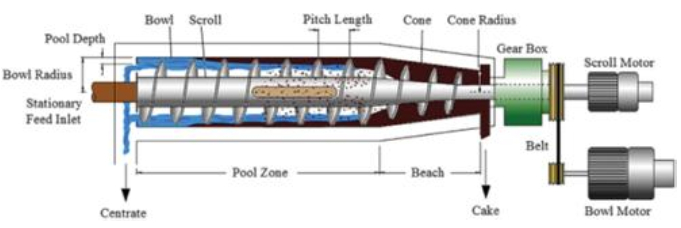









 DownLoad:
DownLoad:
